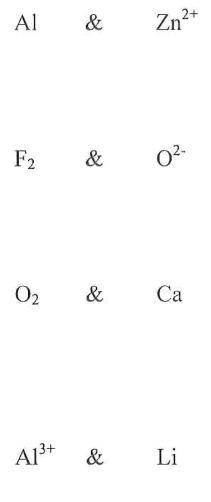
Chemistry, 02.03.2021 01:40, andrewjarrah05
Balance each redox reactions, Identify the entities reduced or oxidized. State the agents.
1. Al + Zn2+
2. F2 + O2-
3. O2 + Ca
4. Li + Al3+


Answers: 3
Other questions on the subject: Chemistry

Chemistry, 22.06.2019 10:10, babyphoraaaaa
For the reaction, 4 a(g) + 3 b(g) => 2 c(g), the following data were obtained at constant temperature. experiment initial[a],mol/l initial [b],mol/l initial rate, m/min 1 0.200 0.150 5.00 2 0.400 0.150 10.0 3 0.200 0.300 10.0 4 0.400 0.300 20.0 which of the following is the correct rate law for the reaction? 1. rate = k[a]2[b]2 2. rate = k[a][b] 3. rate = k[a]2[b] 4. rate = k[a][b]2
Answers: 3

Chemistry, 23.06.2019 09:00, cyni
Which question could be best answered using the process of scientific inquiry? do different plates have different rock compositions? why did it take so long to develop the theory of plate tectonics? what are different cultural myths caused by plate tectonics? do plates move intentionally to cause volcanic eruptions?
Answers: 3

Chemistry, 23.06.2019 11:30, elpeke102p73fz3
Jenny places a strip of ph paper into a solution. when she removes the ph paper, it has turned yellow-green. what should jenny do next to determine the ph of her solution? a. use a different testing method because the ph paper should not change colors b. place the ph paper into a machine that reads the ph of the solution c. compare the ph paper's color with the color of ph paper from another solution d. compare the ph paper's color with a chart of colors and ph ranges
Answers: 1

Chemistry, 23.06.2019 15:30, cicilee49
In a modern periodic table, there are seven periods. a period is any horizontal row of the periodic table, and the elements in a period have consecutive atomic numbers. a group is any vertical column in the periodic table, and there are 18 such groups. groups 3–12, also known as the “b” group elements, are called transition metals. groups 1–2 and 13–18, also known as the “a” group elements, are sometimes called the main groups. metals are characterized by malleability, ductility, conductivity, and a tendency to lose electrons. main group metals are found in groups 1 and 2. nonmetallic elements fall on the right-hand side of the periodic table, that is, groups 13–18. nonmetals have the tendency to gain electrons and are generally brittle. they can be solids, liquids, or gasses at room temperature. now, label the areas of the modern periodic table using the above information. drag the appropriate labels to their respective targets.
Answers: 1
Do you know the correct answer?
Balance each redox reactions, Identify the entities reduced or oxidized. State the agents.
1. Al +...
Questions in other subjects:

Health, 05.01.2021 02:10

English, 05.01.2021 02:10



Mathematics, 05.01.2021 02:10


Physics, 05.01.2021 02:10








